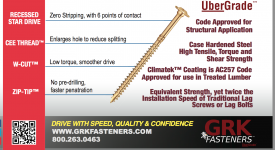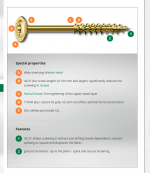Neathawk Designs
Member
- Joined
- Sep 18, 2013
- Messages
- 87
Hello,
I'm in the middle of a project replacing a large roof on a barn. The architect has specified 8" long screws to attach the plywood. I am putting the screws through 5/8" roof sheathing, then through 4" of foam, then 3/4" roof deck, and then almost 3" into the rafters. My Makita 18v impact drivers are barely getting the screws in and it's going terribly slow. In many cases the impact driver stops before getting the screw in all the way.
Which Festool drill might you recommend me trying? I have have at least another 1000 maybe 2000 more screws to put in. Can anyone make any comment on the comparison in driving power between a festool drill (I was looking at the PDC 18) versus a makita 18v brushless?
On a side note - I think that part of the problem is the screws the architect specified are not really a great wood screw. A different screw would probably make a big difference - but finding new screws and getting them approved for the project is quite a pain too -and it may not solve the issue.
Thanks!
Ryan
I'm in the middle of a project replacing a large roof on a barn. The architect has specified 8" long screws to attach the plywood. I am putting the screws through 5/8" roof sheathing, then through 4" of foam, then 3/4" roof deck, and then almost 3" into the rafters. My Makita 18v impact drivers are barely getting the screws in and it's going terribly slow. In many cases the impact driver stops before getting the screw in all the way.
Which Festool drill might you recommend me trying? I have have at least another 1000 maybe 2000 more screws to put in. Can anyone make any comment on the comparison in driving power between a festool drill (I was looking at the PDC 18) versus a makita 18v brushless?
On a side note - I think that part of the problem is the screws the architect specified are not really a great wood screw. A different screw would probably make a big difference - but finding new screws and getting them approved for the project is quite a pain too -and it may not solve the issue.
Thanks!
Ryan



